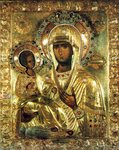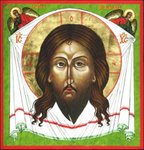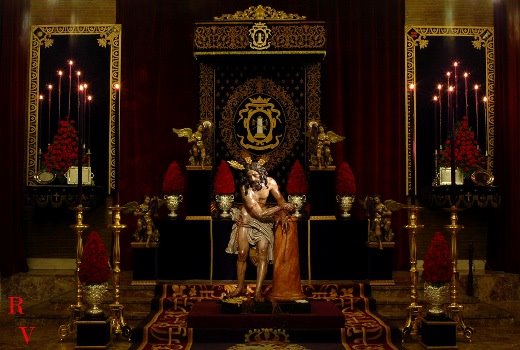(This short story, by the great Filipino writer Nicomedes Marquez Joaquin, is one of my favorites. I have written about this story before, back in 2007, having posted a detailed summary of the events in the story. I am posting it here in full, for the enjoyment of my writers, a number of whom, I'm sure, have long wanted to see this short story online.)
The Mass of St. Sylvestre
To open their doors to the New Year, the Romans invoked the god Janus, patron of doors and beginnings, whose two faces (one staring forward, the other backward) caricature man’s ability to dwell in the past while speeding into the future.
In Christianity, the post of Janus has been taken over by another Roman: St Sylvestre, pope and confessor, whose feast falls on the last day of the year. At midnight of that day, the papal saint appears on earth and, with the Keys of his Office, opens the gates of all the principal archiepiscopal cities and celebrates the first Mass of the year in their cathedrals.
Manila has been a cathedral city almost from its foundation; for centuries it was one of only two cities in the orient (Goa being the other) to whose gates the New Year’s key-bearer made his annual visitation. For this purpose, St. Sylvestre always used the Puerta Postigo, which is—of the seven gates of our city—the one reserved for the private use of the viceroys and the archbishops. There he is met by the great St. Andrew, principal patron of Manila, accompanied by St. Potenciana, who is our minor patroness, and by St. Francis and St. Dominic, the guardians of our walls.
St. Sylvestre comes arrayed in cloth-of-gold and crowned with the tiara. Holy knights suspend a pallium above him; archangels swing censers and wave peacock fans; the book, the Mitre, the Staff and the Keys are borne before him by a company of seraphim; and cherubs flock ahead, blowing on trumpets. Below them swarm the Hours on fast wings. After them come the more sober Days—cryptic figures clad in silver above, in sable below—playing softly on viols. But behind the Pontiff himself, walking three by three, are the twelve splendid angels of the Christian Year.
The first three of these angels are clothed in evergreen and are crowned with pearls, and in their hands they bear incense, gold and myrrh—for these are the angels of the Christmas Season. And the next three angels are clothed in April violets and are crowned with rubies, and they bear the implements of the Passion—for these are the angels of the holy time of Lent. And the next three angels are clothed in lilies and crowned with gold, and they bear triumphal banners—for these are the angels of Eastertide. But the last three angels are clothed in pure flame and crowned with emeralds, and they bear the seven gifts of the Holy Ghost—Wisdom, Understanding, Knowledge, Counsel, Perseverance, Piety, and the Fear of God—for these are the angels of Pentecost.
At the Puerta Postigo the heavenly multitude kneels down as St. Sylvestre advances with the Keys to open the noble and ever loyal city of Manila to the New Year. The city’s bells ring out as the gate opens and St. Andrew and his companions come forth to greet the heavenly embassy. The two bishops embrace and exchange the kiss of peace, and proceed to the cathedral, where the Pontiff celebrates the Mass of the Circumcision. The bells continue pealing throughout the enchanted hour and break into a really glorious uproar as St. Sylvestre rises to bestow the final benediction. But when the clocks strike one o’clock, the heavenly companies vanish—and in the cathedral, so lately glorious with lights and banners and solemn ceremonies, there is suddenly only silence, only the chilly darkness of the empty naves; and at the altar, the single light burning before the Body of God.
Those who have been favoured with glimpses of these ceremonies report that St. Sylvestre (like Janus) seems to have two faces—but these reports are too vague, too confused, and conflicting to be given credence. More respectable is the ancient belief that whoever sees and hears, in its entirety, this Mass of St. Sylvestre will see a thousand more New Years; and it is whispered that Messer Nostradamus succeeded (through black magic) in witnessing one such Mass, while most of Roger Bacon’s last experiments (according to Fray Albertus Magnus) were on a prism that should make visible to mortal eyes this Mass of Time’s kry-bearer. They also speak of a certain magus of Manila, who, like Nostradamus, intruded with black magic upon the sacred scene—and was punished for it.
This magus, who was known was Mateo the Maestro, lived in Manila during the early part of the 18th century and was feared by many as a sorcerer. He was equally famed as a musician, artist, doctor, philosopher, chemist, and scholar; and in his bodega on the street of the Recollects a crowd of apprentices laboured day and night at various arts—carving wood or chiselling stone, or narrating lives of the saints on canvas, or conjugating Latin, or choiring together in rehearsals of a solemn Mass or chanted Rosary. The Maestro—a small, very shrivelled ancient with white hair flowing down to his shoulders and a thin white beard—might look as frail as a mummy, but his eyes—and his temper—were still as sharp as a child’s. Because no one could remember him young he was believed to be hundreds of years old, surviving (some said) from the days before Conquista, when, being a priest of the ancient cults, he wielded great power, wearing his hair long and affecting the clothes and ways of women, but had hidden away from the Castilians in various animal disguises to plot a restoration of the old gods—those fierce and fearful old gods now living in exile on the mountaintops, and in dense forests, and out among the haunted islands of the south, but who steal abroad when the moon dies or when typhoons rage in the night, at which times you may invoke their presence by roasting a man’s liver, and by other unspeakable devices.
The truth, however, was that Mateo the Maestro was not yet eighty years old and could not be remembered as a young man because he had spent his youth in incessant wanderings all over the country, thus acquiring his mastery of the arts, his command of a dozen tongues, and his profound knowledge of herb-healing and witchcraft. Like all magians, he was obsessed by a fear of death and the idea of immortality; but all the lore he had accumulated he found powerless to wrest the secret from life, though he had laboured over countless experiments involving molten gold and pearls, the guts of turtles, the organs of monkeys, and the blood of owls. And after each vain experiment he would bitterly gaze out the window and reflect how, a few steps down the street, in the cathedral, there was yearly said a Mass which—had he but the power to behold it—could increase his life by a thousand years.
He had consulted the dark deities in exile but was informed that the holy mysteries (except by divine dispensation) could be observed only by the eyes of the dead. Whereupon a monstrous idea had grown; the grave of a holy man was profaned; the dead eyes plucked out—and one New Year’s eve Mateo the Maestro hid himself in the cathedral, having grafted into his eye-sockets a pair of eyeballs ravished from the dead.
Just before midnight, he saw the dark naves suddenly light up and a procession forming at the high altar. Garlanded boys bore torches; flower-crowned girls carried lamps; acolytes pressed forward with the cross, the standards, and the censers; and a glittering angel lifted the Flag of the City, its Lions and Castles embroidered in jewels. Behind a company of heralds appeared the mighty St. Andrew, attired in apostolic red and wreathed with laurel. Beside him walked the virgin St. Potenciana, robed in bridal white and crowned with roses. Behind them came St. Francis and St. Dominic and a great crowd of Holy Souls who had been, in life, illustrious citizens and faithful lovers of Manila. Down the aisle advanced the concourse, the cathedral doors swung open, and the Maestro followed the procession down the street to the Puerta Postigo. There the crowd paused in its chanting, and, in a moment of silence so infinite you could hear the clocks all over the world intoning twelve, a key clicked audibly in the lock and (as in Jerusalem and Rome and Antioch and Salamanca and Byzantium and Paris and Alexandria and Canterbury and all the great Sees of Christendom) the gates opened and St. Sylvestre entered the city as the wild bells greeted the New Year, the two processions merging and flowing together to the cathedral.
Now, there was a fine retablo in our cathedral, carved in stone and representing the Adoration of the Shepherds, which at Christmas time was lugged out of its side-chapel and placed upon the high altar. In this retablo, Mateo the Maestro now hid himself, since from behind the kneeling shepherds he commanded a superb view of the ceremonies commencing below. Having been warned that the Mass of St. Sylvestre cannot but prove unbearable to human senses, inducing (like the atmosphere of great heights) a coma in the mortal beholder, he had brought along a knife and a bag of limes, wounding his arms and steeping the wounds with limes each time he felt sleep threatening to overcome him. But as the Mass progressed, it became more and more difficult, it became sheer agony to stay awake. His head swelled and swayed, the purloined eyes fought to squeeze loose from the sockets, slumber pressed down on him like an iron weight around his neck though he stabbed and stabbed till both his arms were bloody blobs of chopped flesh.
But at last the Mass drew to a close; the Pontiff rose for the final benediction. Writhing and sweating, bleeding and smarting, Mateo strained forward, leaning over the kneeling shepherds and forcing his agonized eyes open. St. Sylvestre was standing with his back to the altar—but had he turned his face or was that a second face that stared back at Mateo? Mateo retreated slowly but could not wrench his eyes away from those magnetic eyes below.. he dropped down slowly, irresistibly, to his knees—still staring, still fascinated, his mouth agape. Then he ceased to move: his bones stiffened, his flesh froze. There he knelt moveless00one more kneeling and fascinated figure in a tableau of kneeling and fascinated figures.
Mateo the Maestro had turned into stone.
And there he has remained all these years—and, for generations, bad boys who drowse at Mass have had his crouching form pointed out as a warning. But every New Year’s eve, at midnight, he returns to life. His flesh unfreezes, his blood liquefies, his bones unlock, and he descends from the retablo to join the procession to the Puerta Postigo; sees the New Year come in; hears the Mass of St. Sylvestre; and at the stroke of one o’clock turns into stone again. And so it will be with him until he has seen a thousand New Years.
Or has the spell broken for him at last? For his retablo is broken, the cathedral is broken, and the city he knew has been wiped out by magic more practical and effective than any he ever dreamt of.
…And just as soon as the Liberation Forces opened the Walled City to the public, I went to see what the war had left us of our heritage from four centuries. Nothing had been left—except the oldest and most priceless jewel of all: St. Augustine’s. The Puerta Postigo still stands, but most of the city walls have been levelled to the gorund and the cathedral is a field of rubble. Into what city (I wondered) would St. Sylvestre now make his annual entry? In what cathedral would he say his Mass? The retablo of the Pastoral Adoration has been smashed and dispersed into dust. Does that release Mateo the Maestro from his enchantment—or must he still, on New Year’s eve, reassemble a living body from stone fragments to fulfil his penance of a thousand year?
Later, I told this story to some GI friends, who straightway clamoured that a buddy of theirs, while stationed in the Walled City, had actually witnessed this entry and Mass of St. Sylvestre on New Year’s eve, 1945. Unfortunately, the buddy had gone home to the States; but I took down his address and immediately wrote him, begging for a full account. His name is Francis Xavier Zhdolajczyk and he lives in Barnum Street in Brooklyn.
Here is the letter he sent me:
“… I didn’t know all that about living a thousand years or I might have acted otherwise. If that stuff is true—what a chance I missed! We were camped just outside the walls-on the grassland between the walls and the Port Companies. That night—it was New Year’s eve—I’d come back to the camp early because I was feeling homesick. I was all alone in our tent, the other boys were still downtown celebrating. I lay awake a long time thinking of the war and the folks back home and when I was going to see them. Around midnight I woke up from a doze and heard music. So I stuck my head out and saw a kind of parade coming up the road. I wasn’t surprised then and I wasn’t surprised at anything afterwards. I just told myself that you people must be having one of your New Year’s celebrations and wasn’t it too bad your churches were all smashed up. But I turned my head just then—and there was the Walled City, and it wasn’t smashed up at all. The walls were whole all the way and I could even see some kind of knights in armour moving on top of them. Behind the walls I could clearly see a lot of rooftops and church towers and they were none of them smashed up at all.
I told you about not being surprised—I wasn’t. I simply felt I should go and take a look. So I dressed fast and ran out. The parade had stopped at a gate in the wall and a bishop was opening the gate and bells began ringing. There was another crowd waiting inside and they had a bishop too and the two bishops kissed and then they all went through the gate and I followed. Nobody took any notice of me. Inside, it was a real city, an old city, and hundreds of bells were ringing and they had a park with fountains all around abd beside the park was a cathedral. Everybody was going in there, so I did too.
You never saw such a sight! The bishops were saying Mass and it was all lighted up and the air swelled good like high mountain air and the music was so pretty you wanted to cry. Then I said to myself: what a picture you could make of this, to send home. But I hadn’t brought my camera and I decided to get it. So I ran out and down the street and past the open gate and into our camp. Nobody was around. I got my camera and raced back. When I reached the cathedral I could see that the Mass was ending. I aimed for a nice view—but right when I was going to snap the shutter the bells stopped ringing—and just like that—it all disappeared. The bright lights was only moonlight and the music was only the winf. There was no crowd and no bishops and no altar and no cathedral. I was standing on a stack of ruins and there was nothing but ruins around. Just blocks and blocks of ruins stretching all around me in the silent moonlight…”




















